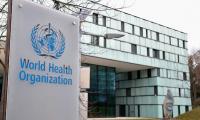Pakistan has embarked on an important economic transformation to join the ranks of emerging market economies. Its three-year economic reform programme, which the IMF supported, has delivered significant gains. The economy is now more resilient, and further steps have been set in motion to support higher, private sector-led, and inclusive growth.
Of course, this reform agenda is an ongoing endeavour. Yet with a more stable economy and gradually increasing growth, Pakistan now has an opportunity to create the conditions for faster job creation and increasing prosperity for all its citizens. Seizing this opportunity requires continuing with the momentum of critical reforms. These are some of the issues I will be discussing during my first visit to Pakistan.
At the global level, prospects remain fragile and subdued. Growth has been too low, for too long, and benefitting too few. This has fuelled populist and inward-looking attitudes in several advanced economies, as many of them are still recovering from the global financial crisis. Emerging economies will therefore have to continue to be the drivers of global growth.
But even here, among emerging markets, growth is rebounding only modestly. Some of the largest emerging economies are undergoing transitions. China is rebalancing from investment to consumption, and from exports to domestic demand. This means a slower, yet more sustainable, growth model – with ripple effects felt mostly in global trade. At the same time, Russia and Brazil are gradually recovering from sharp economic contractions.
In this mixed global environment, Pakistan cannot rely exclusively on its trading partners to support growth. This means that the country will have to lean on the strength of its own policies. Four priorities are central.
First, make the economy more resilient. With uncertain global prospects, the economy needs to prepare for potential shocks that may come down the road. At 65 percent of GDP, Pakistan’s public debt remains too high, with too many resources going toward interest payments instead of public investment, education, and other growth-enhancing areas. The task at hand is to continue improving public finances while accumulating international reserves. In parallel, social safety nets need further strengthening to protect the most vulnerable segments of society.
Second, raise growth. Pakistan can grow at faster rates than the current 4-5 percent per year. This will require higher investment and greater productivity growth. Public investment in infrastructure can help remove obstacles to economic activity, and the China Pakistan Economic Corridor is a very good opportunity. With careful management of its financing arrangements, it can be a transformative success. Yet, the private sector also needs to step up in strengthening economic prospects.
Today, private investment in Pakistan accounts for only 10 percent of the economy – much below the average of 18 percent for emerging markets. Completing energy sector reforms and improving governance and the business climate will be crucial to enable faster private sector growth.
Third, the quality of growth matters. Economic growth in itself is not enough unless its fruits are broadly shared among the population. Two dimensions are very close to my heart: education and gender issues. More than six million children of primary school age, including 3.5 million girls, are currently out of school. Higher spending on public education is clearly important, but so are improvements to the quality of education. The country needs to ensure access to opportunity for all segments of society and equip its people with the skills needed for tomorrow’s job market.
Similarly, with only a quarter of women participating in the labour force, Pakistan can add significantly to its growth potential by integrating women better into the economy. This will make growth not only more inclusive, but also higher. IMF studies have shown that closing the gender gap could boost Pakistan’s GDP by almost one third.
Finally, believe in the global system. Pakistan’s exports are only about a quarter of what they could be based on the experience of emerging markets. There is vast untapped potential to trade with neighbours and integrate into global value chains. A sustained focus on regional and international engagement can help realise this potential.
I am confident that Pakistan can seize this moment of opportunity and transform itself into a dynamic, vibrant, and integrated emerging market country. Over the coming years, a stable and vibrant economy that creates sustainable jobs and spreads the fruits of growth more widely can be a strong force for overall domestic stability. The same applies to trade and cross-border investments, which tend to bring people together in the pursuit of mutual economic advantages, and can provide a stabilizing force in the region.
As I begin my visit to Pakistan, the economic programme that we supported over the past three years has been completed. However, I am looking forward to continuing our partnership through our close policy dialogue and capacity building support.
The writer is the managing director of the International Monetary Fund (IMF).
As in Pakistan lawfare’s impact and prevalence are increasing, situation is turning murkier
Number of traditions are associated with Eid, such as new clothes and giving and receiving of cash gifts as Eidi
Internationally, there have been misleading theories propounded about so-called slowing of Chinese economy
Karachi has long been Pakistan’s financial capital and a major hub for industry and trade
In the past, with every rising of the sun, much anticipation was associated with reading the newspaper
It is clear that more is at stake as US abandons its role as global leader of system based on multilateralism







